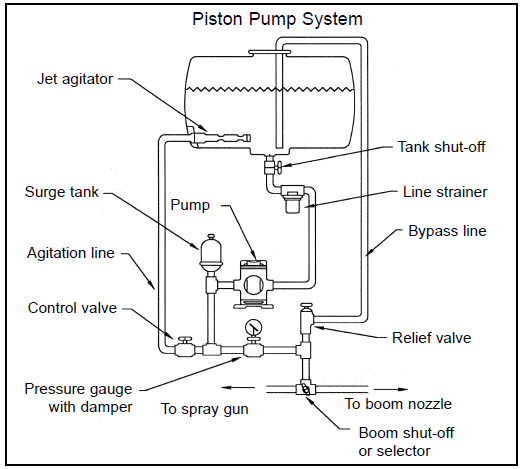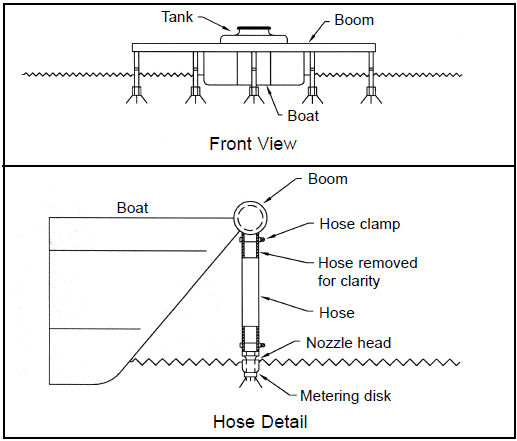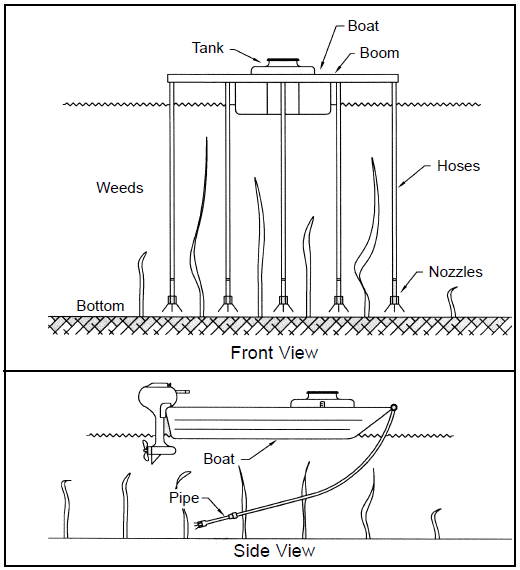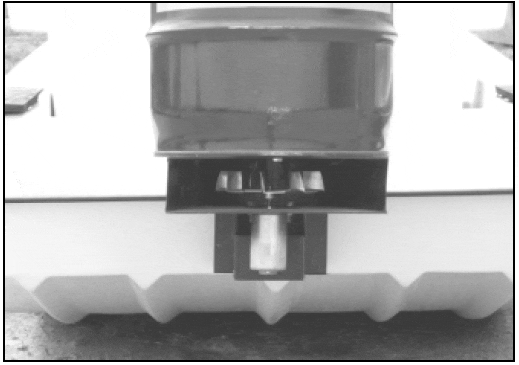Aquatic herbicides are chemicals used to kill aquatic plants or severely interrupt their growth. About 200 herbicides are registered by the EPA for use in the United States, but only six are labeled for use in aquaculture sites. It is important that aquaculturists continue to use these registered herbicides in a safe and effective manner. SRAC Publication No. 361, “Aquatic Weed Management: Herbicides,” discusses herbicide selection and dosage calculations. SRAC Publication No. 360, “Aquatic Weed Management: Control Methods,” contains information on methods of controlling undesirable weeds in fish ponds.
Herbicide Safety
Restricted-use Pesticides
Herbicides with a high potential for damaging the environment require special handling; those who use them must be specially trained. These products are classified as restricted-use pesticides and can be purchased and applied only by licensed, certified applicators or persons working under their direct supervision.
Fortunately, most aquatic herbicides are not restricted-use pesticides. If you need to apply an aquatic herbicide that is listed as a restricted-use pesticide, contact your Extension Service or pesticide regulatory agency about receiving pesticide applicator training.
Preventing Exposure
It is very important to prevent or minimize exposure to herbicides. Herbicide labels and material safety data sheets describe the steps a handler must take to minimize exposure of workers and the environment. Anyone who handles herbicides must read and understand these label statements before using the product.
The main types of herbicide exposure are oral, inhalation, and contact with either the eyes or skin. Oral exposure can be caused by not washing contaminated hands before eating and drinking, or by accidentally splashing herbicides into the mouth. Inhalation exposure is often caused by using herbicides in poorly vented spaces or breathing dust while handling herbicides without appropriate protective equipment. Eye exposure is usually caused by touching the eyes with contaminated hands or handling herbicides without eye protection. Skin exposure happens if a product splashes or sprays on unprotected skin.
You can minimize exposure by mixing herbicides in well-ventilated areas, washing exposed skin areas often and wearing appropriate personal protective equipment that is clean and in good operating condition. Personal protective equipment includes such items as coveralls or protective suits, footwear, gloves, aprons, respirators, eyewear and headgear. The herbicide label lists the minimum personal protective equipment you must wear while handling the herbicide.
Cleanup
All equipment used in mixing and applying herbicides must be thoroughly cleaned after use. This is especially important when using corrosive materials such as copper. The process of cleaning these materials creates “rinsates.” Herbicide container rinsates can be added to the tank during the mixing process. You may also be able to add some rinsates from equipment cleaning, spill cleanup, and other activities to a tank mixture that contains the same herbicide, as long as doing so will not violate label instructions. The final tank rinsates may be added to the treated pond as long as the total amount of herbicide applied to the site does not exceed the rate and frequency allowed on the label. Rinsates that contain dirt, cleaning agents, or other foreign substances are not usable and must be disposed of as wastes.
Empty containers, excess herbicide and wastes must be disposed of in accordance with label restrictions. For information on disposal options in your area contact your state pesticide authority.
When you have finished working with herbicides or application equipment, take time for personal cleanup. Carefully remove your personal protective equipment and any other contaminated clothing. If you cannot take a shower immediately, wash your face, hands, forearms, and any other area that may have come in contact with the herbicide. As soon as possible, wash your whole body and hair thoroughly with a mild detergent and warm water. Wash clothing and personal protective equipment separately from other clothing and household items.
Storage
Often, the smallest amount of herbicide you can purchase is more than you need (e.g., quart bottle, 2.5-gallon container, 40-pound bag, etc.). Fortunately, most aquatic herbicides have a long shelf life and can be used later if stored according to label directions.
Store herbicides in their original containers with the labels attached. Wherever possible, herbicides should be stored in a cool, well-ventilated building. The site should be secure, protected from the weather, and well-lighted. Volatile herbicides, such as some types of 2,4-D, should be stored separately from other chemicals. Keep an up-to-date inventory of herbicides in storage to help in filing damage claims, dealing with fire or flood emergencies, and estimating future herbicide needs.
Herbicide Technology
Classification
Aquatic herbicides are usually grouped according to similarity in absorption characteristics. Absorption characteristics, selectivity, and examples of brand names are presented in Table 1.
Contact herbicides. Contact herbicides are lethal to all plant cells with which they come in contact. They act quickly and are relatively nonselective. This group of herbicides does not move extensively within the plant and may not kill internal plant tissues or roots. Perennial woody plants can be defoliated by contact herbicides but they quickly resprout and often must be treated again. Contact herbicides are more effective on annual herbaceous plants. Endothal, diquat and copper products are contact aquatic herbicides.
Systemic herbicides. Systemic herbicides are absorbed into the plant and then move to other tissues. They act more slowly than contact herbicides but are usually more effective for controlling perennial and woody plants. Systemic herbicides are generally more selective than contact herbicides. Glyphosate, 2,4-D, and fluridone are systemic aquatic herbicides.
Formulations
Aquatic herbicide formulations are composed of active and inert (inactive) ingredients. The active ingredients are the chemicals that control the weed. The inert ingredients are used to dilute the herbicide, make it more effective, or easier to mix and apply. A carrier is an inert ingredient that increases the volume of the formulation, making it easier to mix or apply. The carrier can be water or an oil blend for liquid herbicides, or clay particles for granular or pelletized formulations. Adjuvants are inert ingredients added to the spray solution to facilitate or modify the action of the aquatic herbicide.
A single active ingredient may be available in either liquid or granular formulations. Choose a formulation that works with the type of application equipment you have. Also consider whether spot treatments or whole pond applications will be made, how easy the formulation is to use, and its cost. Most aquatic herbicide formulations fall within one of the following classifications.
Liquids (L). Liquid herbicides are dissolved in water or a water-soluble solvent such as alcohol. These herbicides are easy to mix and do not require agitation during application (which makes them useful where tank agitation is unavailable). The disadvantage of liquid formulations is that their high concentration makes it easy to overdose or underdose through mixing or calibration errors.
Absorption Characteristics, Selectivity, and Brand Name Examples of Aquatic Herbicides Approved for use in Aquaculture Sites.

Aqueous solution or suspension (AS). Aqueous solutions are low solubility herbicides applied to a carrier of fine clay particles that are suspended in water. The formulation must be thoroughly mixed before use because settling may have occurred during storage. AS formulations may also require agitation during application.
Granules (G). The active ingredient in granular formulations either coats the outside of or is absorbed into the carrier (usually clay particles). The amount of active ingredient is usually relatively low (1 to 15 percent). Granular formulations are easy to apply, can be used for partial or spot treatments, and will not drift in the wind. However, they may cost more and are not as effective as foliar treatments.
Slow-release pellets (SRP). Slowrelease pellets are similar to granular formulations, but the active ingredient is released from the carrier over an extended period of time.
Adjuvants
Adjuvants are composed of complex synthetic materials designed for a specific purpose. Adjuvant chemistry and terminology is complicated because most adjuvants are mixtures of many materials. Although most aquatic herbicides have some type of adjuvant incorporated into the formulation, the herbicide label may suggest that additional adjuvant be added. Adjuvants used in aquatic herbicides are generally of three types—activator adjuvants, spray-modifier adjuvants, and utility-modifier adjuvants.
Activator Adjuvants
Activator adjuvants increase the activity of the herbicide by altering the characteristics of the spray solution, the rate of herbicide uptake by the plant, or the evaporation rate.
Surfactants and wetting agents. Surfactants improve the distribution of the spray solution on plant foliage by reducing the surface tension of the liquids involved. Some surfactants also enhance the penetration of the spray solution into the plant by dissolving certain leaf tissue components. Wetting agents help spread the spray solution over the plant surface more evenly.
Emulsifiers. Some aquatic herbicides are formulated as emulsions and have a milky appearance when added to water. Emulsifier adjuvants improve the ability of these herbicide formulations to mix with water. The oil-water emulsion increases the retention time of sprayed material and the rate at which it is taken up through leaf surfaces.
Spray-modifier Adjuvants
This group of adjuvants influences the delivery and placement of the spray solution.
Stickers and spreaders. Stickers and spreaders contain resins, vegetable or mineral oils, waxes or blends of surfactants. These materials have limited use as additives for aquatic herbicides because they are more expensive than surfactants.
Polymers. Aquatic plant control polymers are long-chain carbon molecules used for drift control or as sinking agents. The usage rate is usually 0.1 to 1.0 percent of the total spray volume.
Inverting oils. Inverting oils form droplets of water surrounded by oil. This blend is called an invert emulsion; it resembles mayonnaise. Invert emulsions are used to reduce drift, increase contact time, and cause aquatic herbicides to sink in the water column. Invert emulsions are mixed at a ratio of one part oil to 10 to 30 parts water.
Utility-modifier Adjuvants
Utility modifiers improve the conditions in which the formulated mixture is useful. Buffering agents and antifoam agents are two adjuvants used in aquatic herbicide application.
Buffering agents. Buffering agents may increase the solubility and dispersion of herbicides in low- or high-pH water used in the spray mixture. Buffering agents should be added to the spray mixture before adding the herbicide.
Antifoam agents. These adjuvants reduce foaming in spray mixtures that require vigorous agitation. They are particularly useful in soft water. Antifoam agents are usually silicone-based and used at 0.1 percent or less of the total spray volume.
Methods of Application
Liquid Formulations
Most aquatic herbicides are formulated as liquids. Liquid herbicides can be applied from a spray tank or directly metered into the suction side of a pump for subsurface injection.
Spray tank systems. Spray tanks are best for treating relatively small areas of weeds or when several herbicides are being applied at the same time. The most common tank systems are hand-held or backpack sprayers. They are usually pressurized manually with a hand pump. The volume of these tanks is only 2 to 8 gallons. They are used primarily for spot treatment of floating or emergent vegetation around pond margins.
There are also tank systems that mount on all-terrain vehicles (ATVs). Agitators and pumps are operated by the vehicle’s electrical system. The advantage of these systems is their larger capacity (25 to 30 gallons) and the fact that the operator can ride rather than walk, making it possible to cover more area in a shorter time.
Tanks used in boats are typically constructed from fiberglass and have a capacity of 50 to 100 gallons. To ensure a uniform spray mixture and the proper mixing of adjuvants, tanks of this size should have agitation systems that use either hydraulic or paddlewheel agitators. The pump in a hydraulic agitation system must deliver sufficient capacity to the handgun and the agitator simultaneously. Paddlewheel agitators smallare preferred because they can mix a variety of formulations and have a simple design.
Hoses used to apply herbicides must be chemically resistant and strong enough to withstand the maximum pressure in the system. Hoses should be constructed of ethylene vinyl acetate (EVA) or ethylene propylene dione monomer (EPDM). Damaged hoses can leak or burst and pose a serious threat to applicators. Check hoses frequently and replace them if there is any sign of damage.
The kinds of pumps used for applying liquid herbicide formulations are roller, piston, centrifugal, diaphragm and gear (Table 2). Each type has certain capabilities and limitations that determine when it should be used.
Roller pumps are relatively inexpensive and are widely used in agriculture. While these pumps are adequate for narrow-band pond-margin or small spot treatments, roller pumps do not produce enough sustained pressure for handgun spraying of large areas. Despite a pressure capability rating of 300 psi, the pump would not be able to maintain these pressures because of roller wear that allows fluid to leak back past the rollers.
Piston pumps are often used in aquatic weed control because they can deliver high pressure for handguns. These pumps are dependable, rugged and adaptable to most applications. Unfortunately, they are expensive and prone to pulsation. The pulsing of the flow can be eliminated by using a surge dampener and a surge tank. This type of system should also be equipped with a glycerine-filled pressure gauge because the glycerine dampens the movement of the gauge needle. Piston pumps are positive displacement pumps. The plumbing system shown in Figure 1 is appropriate for all the positive displacement pumps, including the diaphragm and gear pumps. This system uses a relief valve that will bypass fluid back to the tank when system pressure rises too high. Without the relief valve, the pressure would continue to rise until a hose bursts.
Centrifugal pumps are designed to deliver a high flow rate when working against a low pressure. This makes them useful for transferring liquids from one tank to another or for pumping from the body of water into the spray tank when refilling. Many companies sell a small, two-stroke engine coupled to a small centrifugal pump for refilling. These pumps are easy to maintain and have a long service life.
Diaphragm pumps are being used more often than piston pumps because of their relatively low cost, low maintenance, and smaller size as compared to pumps with similar flow and pressure ratings. The pump output depends on pump speed and remains constant regardless of the pressure it is working against. Many units have a range of sizes and drive units.

Pump Characteristics for Application of Liquid Herbicides.

Gear pumps are used less often than diaphragm or piston pumps because of maintenance concerns. The corrosive chemicals in herbicides come in direct contact with the metal pumping gears, which requires more cleaning and shortens the life of the pump. Most gear pumps have unloading valves that activate when the nozzle is closed.
Spray pattern, droplet size and flow rate are determined by the spray nozzle. A smaller variety of nozzles is available for aquatic spraying than for terrestrial application. Nozzle selection is primarily determined by whether the method of application is surface or submersed. There are four primary configurations for aquaculture sites:
- Handgun spraying of surface or emergent species: Handguns are equipped with nozzles that have a high flow rate (3 to 6 gallons per minute), a narrow stream, and large droplet size. This combination of spray characteristics helps to ensure thorough wetting of the weed surface while minimizing drift.
- Subsurface injection just below the water surface for submersed weed control: Hoses are long enough to place the nozzles at or just below the water surface (Fig. 2). Hoses are evenly spaced at 2-foot intervals along a bow- or stern-mounted boom. The nozzle body contains a disk that meters the flow into the water.
- Bottom placement for deepwater injection: Nozzles are located at the ends of long hoses that trail from a boom on the bow of the application boat (Fig. 3). Hoses are weighted to keep the herbicide placement within the weed mat or near the bottom. One method used to weight hoses is to construct a nozzle by drilling an outlet hole into the end of a short length of capped galvanized pipe. Pipe length (9 to 30 inches) is based on the amount of weight needed to maintain the nozzle at the desired depth. Hoses should be free of any clamps or other protrusions that may foul on plants.


Direct metering into pump. When there are large areas to be treated, it is more efficient to meter the herbicide into the suction side of the pump and eliminate the mixing tanks and the time spent filling the tanks. Water is drawn into the pump through “water boxes” built into the bottom of the spray boat. Herbicide is drawn from containers through suction hoses that are tapped into the pump suction line. These suction hoses are typically plastic and contain a valve for opening and closing the lines and an in-line orifice to meter the correct amount of herbicide into the system. With multiple suction hoses the operator can change from empty to full containers without interrupting the application. When a herbicide container becomes empty, the operator simply opens the valve in the hose in a new container and closes the valve of the empty one.
Granular Formulations
Granular applications can treat a wide swath (30 to 40 feet) without having equipment extending beyond the sides of the boat. Unfortunately, this requires that a large amount of material (20 to 400 pounds per acre) must be handled.
Granular herbicides are usually applied with a bow-mounted centrifugal or blower-type spreader (Fig. 4). Centrifugal spreaders use a 12-volt DC motor to drive a rotor that distributes the granules. Blower-type spreaders use air pressure generated by a low-pressure, high-speed, 2-cycle blower. Blower-type spreaders create much less dust than centrifugal spreaders.

Dosage Rate Concerns
Applying either too much or too little herbicide can cause problems. Using more herbicide than the label recommends is expensive, potentially toxic to fish, and illegal. Applying too little herbicide may not fully control the weed; repeat treatments, if not prohibited by label restrictions, can be costly.
Calculating the area of aquaculture ponds is fairly simple compared to recreational ponds, because most aquaculture ponds have straight levees, are mostly rectangular in shape, and have a uniform depth. They can be accurately measured with measuring wheels, with tape measures, or from construction diagrams. Pond areas should remain constant unless they are reconstructed or unless extremely low water levels reduce the amount of surface area (as in watershed ponds). For information on calculating the areas and volumes of ponds see SRAC Publication 103, “Calculating Area and Volume of Ponds and Tanks.”
A common mistake in calculating treatment rates is incorrectly estimating water depth. Pond depth can fluctuate with a change in rainfall or runoff, or when erosion increases the depth of pond bottom sediments created by erosion. The result of miscalculating pond volume can be dramatic, as illustrated by the following example:
Based on original construction diagrams, a commercial catfish pond is estimated to have a surface area of 12 acres and an average water depth of 4.5 feet. The pond is to be treated with a 0.25 parts per million (ppm) treatment of Hydrothol 191® to control branched algae. How many pounds of Hydrothol 191® should be used?
From SRAC Publication 361, “Aquatic Weed Management: Herbicides,” the amount of herbicide needed for an acre-foot (volume) treatment is determined with the following formula:
F = A x D x R, where
F = Amount of formulated herbicide product
A = Area of the water surface in acres
D = Average depth of water in feet
R = Recommended rate of product per acre-foot
Therefore:
F = 12 acres x 4.5 feet x 13.75 pounds / acre-feet = 742.5 pounds of Hydrothol 191®
If the average water depth had actually been 3.5 feet because the pond was 6 inches below capacity and 6 inches of sediment had accumulated on the bottom, the actual volume of the pond would be 42 acre-feet, not 54 acre-feet. This would have resulted in an over-treatment of 22 percent and an increase in the dosage rate to 0.32 ppm. Applications above 0.3 ppm Hydrothol 191® may be toxic to some fish species. If the water depth (4.5 feet) had been correct but the surface area just 11 acres, the application would have resulted in an over-treatment of 8 percent and an increase in the dosage rate to 0.27 ppm.




